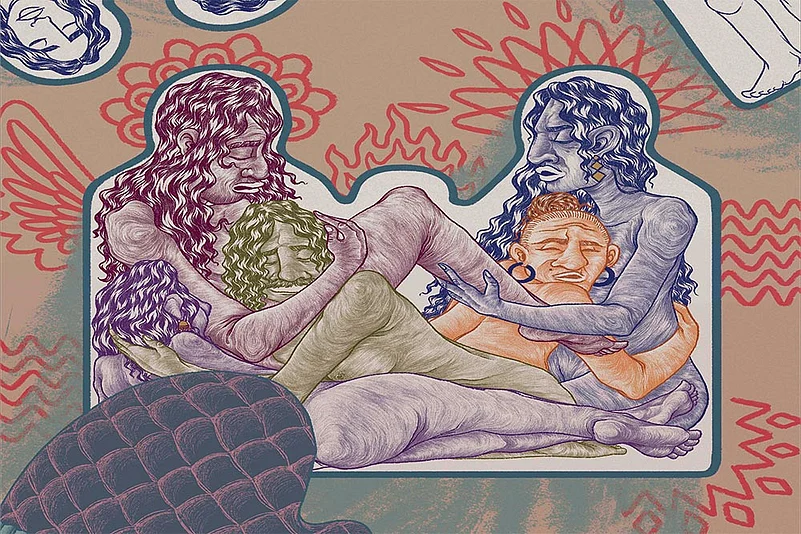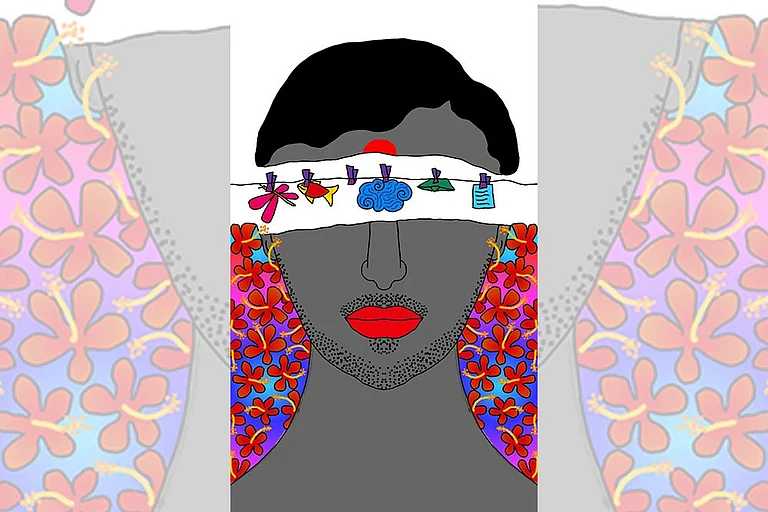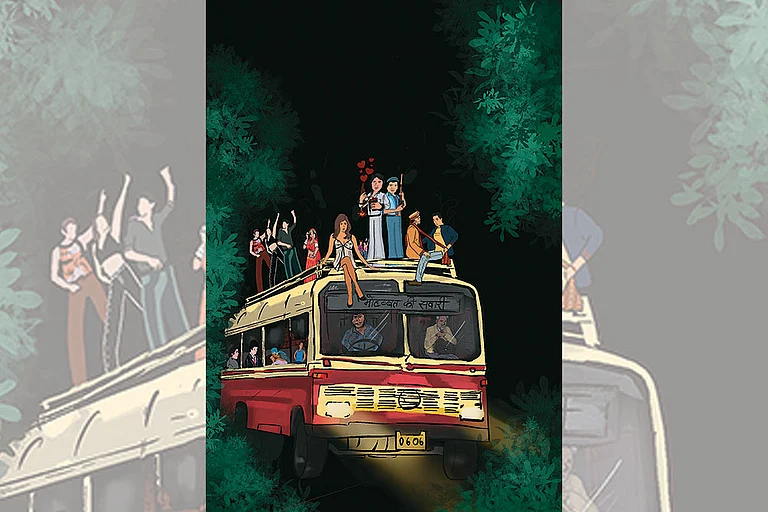“It was akin to cutting off of a metaphorical umbilical cord”, says Sayema.* She had to walk out on her natal family who abused her for weeks when they found out she was a lesbian. Dealing with violence and discrimination from her family was devastating. “I don’t know what my life would look like if my chosen family had not come to my rescue,” she adds.
For Sayema, coming out to her family became an absolute necessity. “As a woman in her 30s in India, my family naturally was on the lookout for an appropriate groom. I rejected several men and then, to get out of the rut, I informed them that I am, in fact, queer,” she said.
Sayema recollects that she was always sure of her sexuality but coming out to her family wasn’t an option for the longest time.
For many queer people in India, coming out to their biological family is not an option. Many fall prey to societal pressure and find themselves trapped in heterosexual marriages. According to a 2009 survey by Mumbai-based non-governmental organisation (NGO) Humsafar Trust, nearly 70 percent gay men in Mumbai find themselves trapped in such heterosexual marriages.
Being queer in a heteronormative society is isolating for several reasons. Perhaps the most alienating is being rejected by one’s family.
‘All the dead boys look like me’
Abigail Silversmith recalls how her father pathologised her frequent ‘crying’ bouts and femininity at 14-years-old. She recalls “I didn’t know I was a transgender individual exactly. My father took me a psychiatrist when I was a teen. I was technically forced out of the closet by my parents.” She was admitted to the psych ward in a hospital in Kerala so she could be “fixed”. The fact that she had autism only made matters worse.
The memory of the ward is fresh for Abigail. She was placed in a ward with another minor who was trans. “Treatments” included electrocution and medication. Her family hired a priest who performed an exorcism on her. “It was a strange voodoo session that somehow required a chicken be rubbed across my body,” she says. Recalling this time in her life, Abigail’s laughter is hysterical; perhaps because she survived and can tell the tale. The other minor in her ward cannot. “She died by suicide, in my arms.”
What Abigail describes is conversion therapy or Sexual Orientation Change Efforts (SOCE). She’s undergone conversion therapy twice – as a teen and again as an adult. At 22-years-old, she was again subjected to ‘reparative interventions’ at a hospital in Kerala. “I was kidnapped from my place and taken to Kerala by my family in a bid to correct me,” she said. They thought they could beat the femininity out of me, she added.
In May 2020, the death by suicide of a 21-year-old bisexual woman, Anjana Harsh, sparked protests across India. Harish had posted a video to her social media describing how her family subjected her to conversion therapy in Kerala. Activists demanded a ban on the process entirely.
In June of the same year, the UN Human Rights Council (UNHRC) received a report from an independent expert Victor Madrigal-Borloz who had visited several countries including India. Madrigal-Borloz, an expert in gender and sexuality, studied over 100 countries where conversion therapy was used, and interviewed 8,000 respondents who had to endure it. His report states that 98 percent of the people said the experience had caused them both physical and psychological harm. The report noted that “conversion therapy amounts to torture, and should be banned.” The UNHRC has yet to call for a ban.
In India, it took a young woman approaching the Madras High Court in 2021 for lawmakers to set a ban in motion. It was Justice Anand Venkatesh who declared that any attempts to medically ‘cure’ or change the sexual orientation or gender identity of LGBTQIA+ persons must be prohibited. The court directed action against professionals involved in any form of conversion therapy, including the withdrawal of their medical licence.
Still, it wasn’t till 2022 that National Medical Commission (NMC) to ban ‘conversion therapy’ and categorise it as professional misconduct in 2022. Despite this ban, quacks continue practicing conversion therapy to “cure” queer people. ‘Yes We Exist’, an online forum dedicated to creating awareness around queer issues reported on June 26, 2024, that Amrita Hospital in Kerala is allegedly using the illegal, unscientific and cruel practice of conversion therapy on a transwoman named Elida Rubielle.
Lack of legislative support is a major hurdle in criminalising conversion therapy. The violence against queer folks at the hands of their natal family is not limited to conversion therapy and exorcism. Corrective rapes are also used to cure “queerness” by families.
When Kishor*, a gay transman, came out to his family at 18-years-old, they took him to a self-styled godman. “He raped me as a corrective measure,” said Kishor. As he talks of this experience, Kishor has to cough to dislodge the anger and grief that form a lump in his throat.
He called his friends who arranged some money for his journey ahead. Kishor now lives in a metropolitan city and has found himself a job at an NGO working for fellow queer folks.
The Chosen Kin
The term “chosen family” can be traced to anthropologist Kath Weston’s book, Families We Choose: Lesbians, Gays, Kinship. Based on research conducted in San Francisco in the late 1980s, it explores how lovers and close friends ended up playing the roles of parents and siblings, aunts and uncles, cousins and grandparents in the lives of queer folks who had been ostracised by their biological families.
Advertisement
In South Asia, the most common form of kinship among the hijra community is the guru-chela tradition. The role of guru is assumed by the oldest member of the ‘family’ who is generally the one with the most social and financial standing. The disciples or chela are entrusted with bringing in money to support the house in exchange for ‘roti, kapda, makaan’ and some familial love, care and affection. However, there have been instances of violence within this form of kinship as it is also deeply hierarchical.
A 2018 study commissioned by the National Human Rights Commission (NHRC) revealed that just two percent of the trans people surveyed live with the families into which they were born.
Advertisement
Sayema, Abigail and Kishor found themselves in a violent space exacerbated by alienation from their natal families but their chosen kin came to their aid in the hour of need.
Still it’s hard not to long for familial acceptance. Kishor says his friends are his family. But he wonders, would it not be something if my parents would just give me a call to say they love me?
Acceptance vs. Understanding, and the Grief that Goes With it
Others gain acceptance but not understanding. Sayema’s last meeting with her parents was amicable. “They accepted me as their daughter, but not my queer self. They are able to cope with my queerness by compartmentalization—my identity as a queer individual is outside their realm of understanding, and belief systems, which is hard to break down.”
Advertisement
She was told by her elder brother that their parents recently watched Manoj Vajpayee starrer Aligarh and some other films that deal with queer subjects. “This might help them understand who I am and what life looks like for a queer person,” she adds.
“The worst is when your family abandons you but you can’t seem to shake them off,” says Kishor who is still in touch with his younger siblings.
Abigail too visited her family a week ago as her father met with an accident and ended up paralysed. Scared out of her wits, she shared her live location with her friends. “They made me change into ‘boys’ clothes before I saw my dad. The grief is greater for my mother who is losing her husband. For me, while I grieve for my father, I also grieve for me—who I was and who I could have been,” she adds.
Advertisement
(This appeared in the print as 'Of Queer Existence And Chosen Families')






















